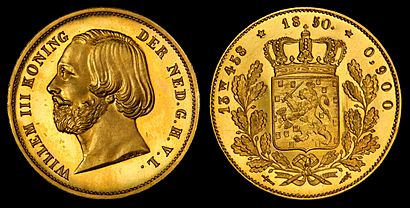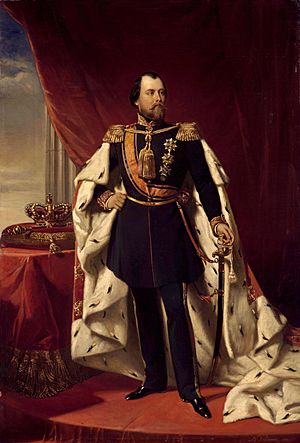William III of the Netherlands facts for kids
Quick facts for kids William III |
|||||
|---|---|---|---|---|---|
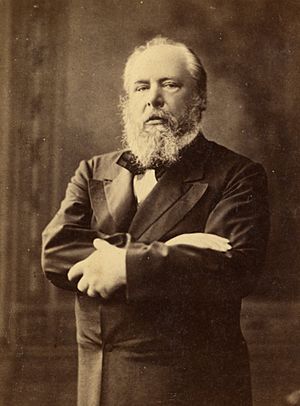
Photograph by Maria Hille, c. 1887
|
|||||
| King of the Netherlands | |||||
| Reign | 17 March 1849 – 23 November 1890 | ||||
| Inauguration | 12 May 1849 | ||||
| Predecessor | William II | ||||
| Successor | Wilhelmina | ||||
| Grand Duke of Luxembourg | |||||
| Reign | 17 March 1849 – 23 November 1890 | ||||
| Predecessor | William II | ||||
| Successor | Adolphe | ||||
| Duke of Limburg | |||||
| Reign | 17 March 1849 – 23 August 1866 | ||||
| Predecessor | William II | ||||
| Born | 19 February 1817 Palace of the Nation, Brussels, United Kingdom of the Netherlands |
||||
| Died | 23 November 1890 (aged 73) Het Loo Palace, Apeldoorn, Netherlands |
||||
| Burial | 4 December 1890 Nieuwe Kerk, Delft, Netherlands |
||||
| Spouse | |||||
| Issue among others... |
|
||||
|
|||||
| House | Orange-Nassau | ||||
| Father | William II of the Netherlands | ||||
| Mother | Anna Pavlovna of Russia | ||||
| Religion | Dutch Reformed Church | ||||
William III (Dutch: Willem Alexander Paul Frederik Lodewijk; English: William Alexander Paul Frederick Louis; 19 February 1817 – 23 November 1890) was the King of the Netherlands and Grand Duke of Luxembourg from 1849 until he died in 1890. He was also the Duke of Limburg from 1849 until that area was no longer a duchy in 1866.
William was the son of King William II and Anna Pavlovna of Russia. When his grandfather, William I, gave up his throne in 1840, William became the Prince of Orange. When his father died in 1849, William became the new King of the Netherlands.
William married his cousin Sophie of Württemberg in 1839. They had three sons: William, Maurice, and Alexander. Sadly, all of them died before their father. After Sophie died in 1877, William married Emma of Waldeck and Pyrmont in 1879. They had one daughter, Wilhelmina, who later became Queen of the Netherlands.
Since William was the last male heir in his family line for the Grand Duchy of Luxembourg, that throne went to a distant cousin, Adolphe. As of 2022, William III is the last Dutch king to die while still on the throne. All the kings and queens after him have chosen to step down for their children.
Early Life and Family
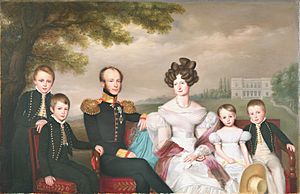
William was born on February 19, 1817, in Brussels. At that time, Brussels was part of the United Kingdom of the Netherlands. He was the oldest son of the future King William II of the Netherlands and Anna Pavlovna of Russia. He had three brothers and one sister. One of his brothers died when he was very young.
When William was ten years old in 1827, he was made an honorary colonel in the Royal Netherlands Army. In the 1830s, he served as a lieutenant in the Grenadiers Regiment. He was also made an honorary commander in the Russian Army.
On June 18, 1839, he married his cousin, Sophie of Württemberg, in Stuttgart. Their marriage was not very happy. They often disagreed about how to raise their children. Sophie was a very smart person who liked new ideas, while William was more traditional and loved the military. He sometimes made it difficult for Sophie to pursue her intellectual interests at home.
William did not like the changes made to the Dutch constitution in 1848. These changes were started by his father, William II, and a politician named Johan Rudolf Thorbecke. William's father believed these changes were important for the monarchy to survive. However, William thought they limited the king's power too much. He would have preferred to rule with complete authority, like his grandfather, William I.
He even thought about giving up his right to the throne to his younger brother, Henry, or later to his oldest son. But his mother convinced him not to. The Dutch constitution did not have a way for someone to give up their claim to the throne.
On March 17, 1849, his father died, and William became the new King of the Netherlands. He was visiting England at the time. Dutch government officials traveled to London to meet their new king. William was not eager to return home, but they convinced him. When he arrived, his wife, the new Queen, asked him if he had accepted the throne. He nodded, but he remained unsure for a while.
William's Time as King
William often thought about giving up his throne once his oldest son, William, Prince of Orange, turned eighteen. This happened in 1858, but William found it hard to make a decision, so he stayed king. His first official act was to approve the government led by Thorbecke, the liberal politician who designed the 1848 constitution. William did not like Thorbecke.
In 1853, the Roman Catholic bishops were allowed to return to the Netherlands. This gave William more support from conservative groups, and he used this to dismiss Thorbecke. In the first twenty years of his rule, he often dismissed governments and dissolved the States-General (the Dutch parliament). He would then set up his own royal governments, which would rule as long as they had support in parliament.
In 1856, William made a new, strict constitution for Luxembourg, which he ruled separately from the Netherlands. This event became known as the "Luxembourg Coup of 1856".
In 1867, France offered to buy Luxembourg. This led to the Luxembourg Crisis, which almost caused a war between Prussia and France. However, a treaty signed in London in 1867 confirmed that Luxembourg would be a fully independent country.
During his reign, the king became less popular with the middle-class liberals. His unpredictable actions often led to their resistance and even jokes about him. However, he remained quite popular with ordinary people.
The king was a very tall and strong man with a loud voice. He could be gentle and kind, but then suddenly become scary and even aggressive. He sometimes treated his servants poorly. He was also known to be harsh with animals. His government ministers were often afraid of him. Many people around him thought he was sometimes unstable.
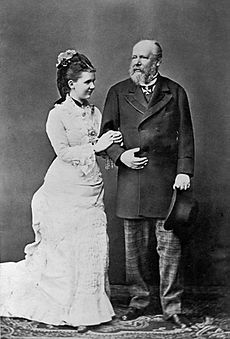
The king could be very unpredictable. He sometimes ordered people to be fired, arrested, or even executed if he felt they disrespected him. These orders were usually ignored by his staff. The king also thought he was an expert in military matters and often tried to take command during army exercises, which usually caused confusion.
In 1877, Queen Sophie died, ending years of tension in the palace. That same year, King William announced he wanted to marry Émilie Ambre, a French opera singer. He even tried to give her a noble title without the government's approval. Because of pressure from society and the government, he gave up these marriage plans.
William still wanted to remarry. In 1878, he first suggested marrying his niece, Princess Elisabeth of Saxe-Weimar. He then thought about marrying Princess Pauline of Waldeck and Pyrmont or Princess Thyra of Denmark.
He finally decided to marry Pauline's younger sister, Emma. Some politicians were upset because she was 41 years younger than the king. However, Emma turned out to be a very kind woman. William asked parliament for permission to marry, which was easily granted. They quickly married in Arolsen on January 7, 1879.
Emma had a calming effect on William's unpredictable personality, and their marriage was very happy. The last ten years of his reign were definitely the best. The king stopped getting involved in most government matters. In 1880, Wilhelmina was born. She became the next in line to the throne in 1884 after William's last remaining son from his first marriage died. Many possible male heirs had died between 1878 and 1884.
King William became very ill in 1887 with a kidney problem. However, in 1888, he personally gave a gold medal to Dorus Rijkers, a hero who saved 20 people from a shipwreck.
In 1888 and 1889, the sick king became increasingly unwell mentally. The Council of State and then Queen Emma became regents, meaning they ruled in his place. William III died in Het Loo in 1890. Because Wilhelmina was not yet an adult, Emma continued to be regent for her daughter. She remained regent until Wilhelmina turned eighteen in 1898.
Family and Children
William III had four children who were considered legitimate. Three of them lived to be adults: two sons from his marriage to Queen Sophie and one daughter from his marriage to Queen Emma.
- Willem Nicolaas Alexander Frederik Karel Hendrik (1840–1879). He was the next in line to the throne from 1840 until he died.
- Willem Frederik Maurits Alexander Hendrik Karel (1843–1850).
- Willem Alexander Karel Hendrik Frederik (1851–1884). He was the next in line to the throne from 1879 until he died.
- Wilhelmina Helena Pauline Maria (1880–1962). She became Queen of the Netherlands from 1890 to 1948.
William III was a very tall and strong man, standing at 6 feet 5 inches (196 cm).
Honours
- National honours
- Founder and Joint Grand Master of the Order of the Gold Lion of Nassau, March 16, 1858
See also
 In Spanish: Guillermo III de los Países Bajos para niños
In Spanish: Guillermo III de los Países Bajos para niños


